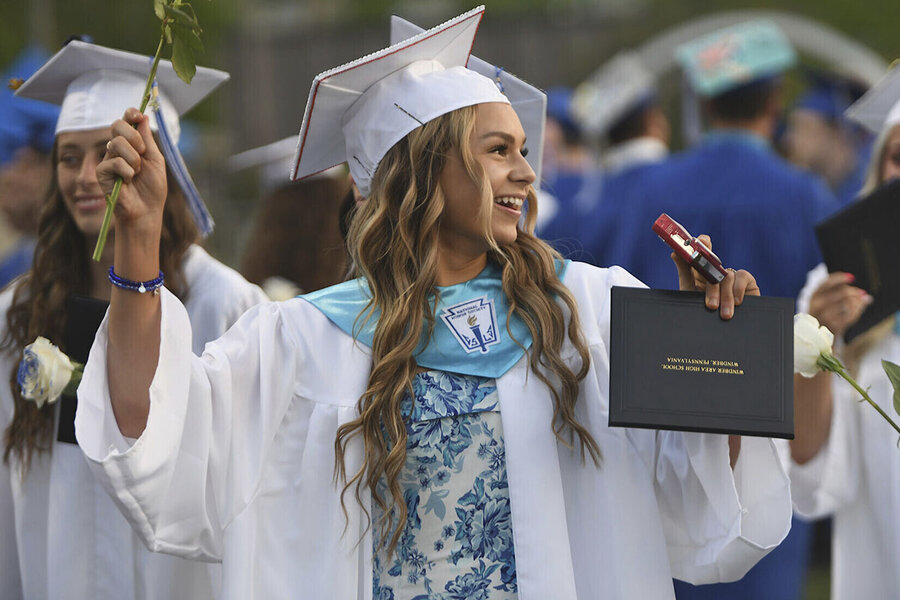How to get absentee students their diploma? Add lots of caring.
Loading...
As Jared Aaron progressed through school in Atlanta, graduation served as a North Star – until a family move his junior year disrupted that pathway.
When he eventually registered at Benjamin E. Mays High School, he knew he had a lot of ground to make up, having missed a year of school.
“My initial graduation thought was to be at least top 20% of my class [and] get all A’s and B’s,” he says. After he fell behind, he realized he was “going to have to work harder” to finish high school.
Why We Wrote This
A story focused onFacing chronic absenteeism, how are high schools helping students cross the graduation finish line? Often, it comes down to three words: connection, flexibility, and relevance.
On Thursday, Jared plans to accept his diploma alongside his senior class peers. He finished on time, a feat he attributes to Phoenix Academy in Atlanta Public Schools. It’s a program that serves students at risk of not graduating by providing extra support through a blended learning environment.
Staggering increases in chronic absenteeism among students, educators say, could torpedo diploma attainment if steps aren’t taken to curb the problem and get teens back on track. And, as some schools are finding out, students are succeeding after building connections with peers or trusted adults and being offered more flexibility.
“I’m definitely worried,” says Chelsea Montgomery, assistant superintendent for student services at Atlanta Public Schools. “I think we’re going to see the impacts for the next several years.”
Students are labeled chronically absent if they miss more than 10% of school days for any reason. In states with 180 school days, for instance, the math translates to students missing at least 3 1/2 weeks of instruction. Some students, like Jared, essentially drop off the radar and forgo attending school for months at a time.
Attendance Works – a nonprofit that works with school districts, community organizations, and states to reduce student absences – estimates that chronic absenteeism roughly doubled since the pandemic, affecting nearly a third of students. During the 2021-2022 school year, chronic absenteeism rose in many corners of the United States, reaching 30% in states such as New Mexico, Ohio, and California.
Hedy N. Chang, executive director of Attendance Works, doesn’t expect those rates to drop significantly – maybe just by a few percentage points – when data comes out for the current school year.
“School learning is very scaffolded,” she says. “There’s a lot of evidence that shows missing too much of a course can cause you to fall behind, not pass the test, then fail the class and then be off track for graduation.”
Leading up to the pandemic, the national graduation rate had been steadily increasing, moving from 79% in 2011 to 86% by 2019. In 2020, despite the massive shift to remote learning, the graduation rate inched up again to 87%, according to the National Center for Education Statistics, which has not released more recent data. Some states relaxed standards at the beginning of the pandemic to get students across the finish line during the tumultuous period.
Douglas Harris, a professor and economics department chair at Tulane University who studies graduation rates, suspects a degree of flexibility persists despite school districts largely returning to business-as-usual academic operations. He says that may stem from a desire to make high school more manageable because the alternative – students giving up and dropping out if they feel the challenges are too insurmountable – is worse.
“My sense is that some of that has continued beyond the pandemic and that’s why it’s been easier for students to meet the requirements that they need to graduate,” he says.
“We can make that work”
Georgia never altered its graduation requirements, but when it comes to flexibility, Ms. Montgomery says it’s about meeting students where they are. The Phoenix Academy, in particular, models that sentiment: Some students come in person every day for in-person support from teachers. Others visit a few times a week or work remotely and receive virtual assistance.
It’s an acknowledgement that students’ lives don’t always fit into the neat and tidy contours of a typical school week, especially given changes some experienced during the pandemic.
“If they need to work, that’s OK,” she says. “If you can’t do school on Tuesdays and Thursdays because you have to take care of your grandmother those days, that’s fine. We can make that work. So really, especially with COVID world, having that flexibility to make it work ... has just been critically important.”
Ms. Chang says another antidote to chronic absenteeism and, consequently, a key factor affecting graduation, is relationship-building – both among students and their peers and trusted staff members.
That’s how Darlene Montano recently found herself writing a letter to the superintendent of Albuquerque Public Schools in New Mexico. She wanted to tell him about the profound effect a high school counselor, Brenna McJimsey, had on her son, Marcos. Without Ms. McJimsey’s constant encouragement and progress monitoring, she says her son likely would not be graduating.
Marcos fell behind and didn’t graduate with his original senior class in 2021. He almost called it quits, in part because his mother sustained severe injuries in a car accident.
“I still worried a lot, so I just wanted to be there,” he says of taking care of his mother.
But Ms. McJimsey kept nudging him to not give up. Marcos, now 19, earned the final credits he needed to graduate this spring and embark on his next chapter: following in the footsteps of his father to become an electrician. Marcos says his rapport with Ms. McJimsey made all the difference.
“She made me believe in myself for once,” he says.
Ms. McJimsey says she makes it a point to treat each student with humanity and establish trust. When she noticed a string of absences, she would reach out to Marcos with a simple message: “The more you keep doing [school], the closer you’re going to get.”
The approach echoes what Yusuf Muhammad, principal of Phoenix Academy, tries to instill among his staff members. Caring adults combined with frequent progress monitoring, he says, can help even the most vulnerable students finish high school.
Of the program’s 500 students this year, leaders expect about 250 to graduate this spring followed by another 100 receiving their diplomas this summer. Others may need an additional semester or two to reach that milestone.
“If you believe that students can succeed, regardless of circumstances, then we’ll prioritize what’s best for students – not necessarily what’s best for adults – and we can really push students through,” Mr. Muhammad says.
Helping students make connections
Another piece of the puzzle, Ms. Chang says, is relevancy. Students tend to engage more if they see a connection between what they’re learning in school and potential career pathways, or if a school project helps solve a community problem.
“It’s them seeing the relevance of the skill they’re learning to the world in which they live,” she says.
For Jared, it also took a large dose of grit. He knew it was “crunch time” this year. The soon-to-be high school graduate is taking a Google course relating to information technology support while also pondering his next steps.
The weight of the moment, he says, isn’t lost on him as society looks to his generation as the next leaders. “It’s gonna get real from here,” he says.






